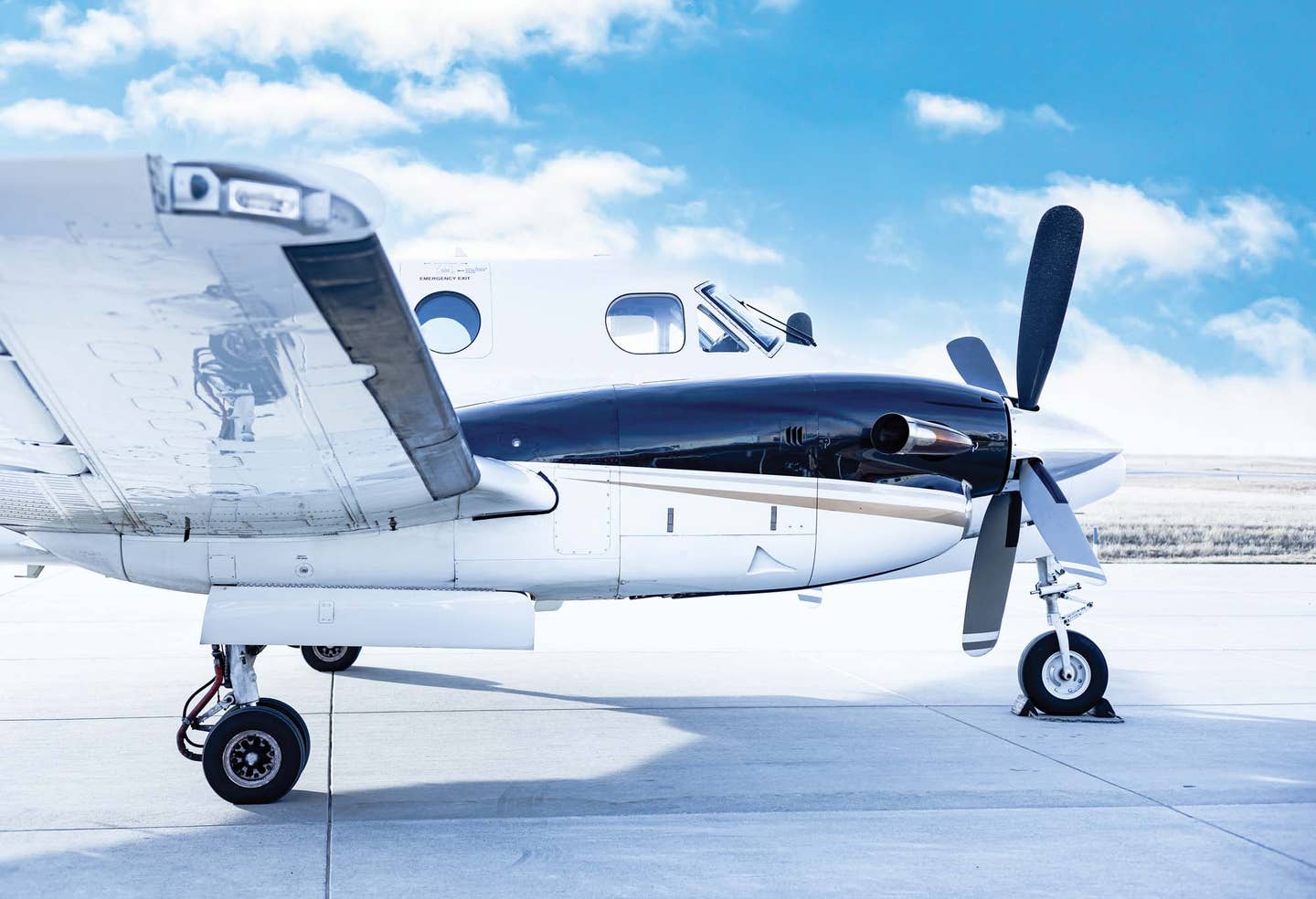Ticket To Ride II
Part II: Practice, practice, practice, home study, and what? Time to solo already? Gulp.
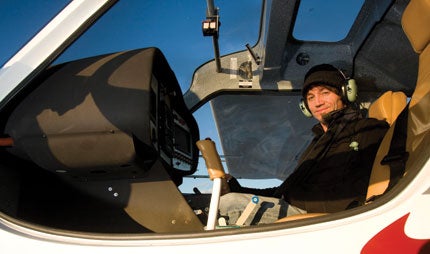 Instructor John Lampson |
In our April 2009 issue, Jim Lawrence launched the first in his series of articles about LSA training in a Flight Design CTLS. This month, he takes us through solo.
The washboard-road days of early spring turbulence are behind us now. Below, the green/gold farms and blue gem lakes of Massachusetts ease by. The viz from the left seat of 860LS, our smooth and steady CTLS, is simply great. It's CAVU---60 miles south lie the sparkling Connecticut coast and a dusky smudge of near-shore islands. To the west, though, a black wall looms. Weather says thunderstorms by 6 p.m.; it's after 5 now.
It's good to be flying after another long training break. My ever-cheery, rock 'n' rollin' instructor, John Lampson, has patiently put me through the paces. I'm more relaxed in the bird now, much smoother with the controls, the forward sight picture, flight trim settings and radio work---ah, radio work, that great ego equalizer.
Today, says Lampson, could be solo day. But I'm eyeing that wall of coal-dark cloud 10 miles away, thinking, "Well, maybe. And maybe not." Because if there's one thing I learned from hang gliding in the mountains, it's this: You don't mess with the thunder.
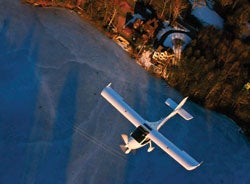 Flight Design's CTLS , Jim Lawrence confidently progresses toward the sport pilot certificate. |
The Long March
It has taken around 14 hours of dual to get here. New England weather and scheduling demons have spaced our flights over many weeks. Until a breakthrough day a ways back, I was still fighting the airplane, still a bit tense landing and, overall, more tentative than I expected to be. Expectation: like guilt, a waste of mind energy.
At least I've adapted to the curved-cowl sight picture. No more racing diagonally off the runway or flaring to land in an unintentional crab. But that sticky throttle lever continued to bug me. I couldn't work it smoothly like Lampson, with his strong, guitar-plucking fingers. Curse you, rock-star CFI!
We've gone through the time-honored airwork: takeoffs and landings, pattern flying, approach and departure stalls, slow flight, turns about a point---the Full Monty of flight training. Any notions I'd had that sport pilot training would be a few duals, then an easy solo, XC and checkride, have long since been dispelled. For example, the CT's excellent power-off glide still keeps fooling me into too-high approaches on final.
I've come to appreciate the CT for the stable, fast and slow, comfortable bird it is. It feels solid and secure in flight. Like many LSA, stall recovery is nominal: Just relax the stick forward or feed power, and you're flying again. There's plenty of near-stall force feedback through the stick, and no sharp wing falloff at the break. You have to work, in fact, to get it to break at all.
It's becoming second nature to use my feet in this rudder-hungry bird. Less twitchy than its forebearers (CT2K and CTSW, with their shorter fuselages), the CTLS still likes lead rudder in and out of turns for controlling adverse yaw. It also needs a firm right foot for launch and ditto with the left when the power comes off.
The cool thing about learning to fly comes when you discover you're doing things automatically, such as leading with rudder into a turn, that you had to think about in the beginning. Lampson has even taught me to keep wings level in slow flight using rudder only---no ailerons. That's a great skill to hone.
The CTLS is still a slippery, aerodynamically sophisticated design, though. It can get away from you a bit if you try to muscle it around. Speed can build quickly with just a dip in the nose. In turbulence, you feel little bumps more acutely due to the minimally flexing carbon-fiber/composite airframe, so putting too much effort into keeping wings level can be tiring. Lampson's quick fix: flip on the superb TruTrak autopilot, crank on the satellite radio and kick back!eyes always scanning for traffic, of course.
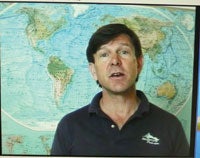 ASA's Paul Hamilton |
Getting To Know You
Lampson had promised early on, after my initial discomfort flying the airplane, that I would grow to love the CT. He was right. I feel confident at the controls now. I'm thinking ahead and adapting to conditions as I should be.
And the cockpit? Fits like a glove. The loaded panel is yummy with those big Dynon dual EFIS-D100 and EMS-D120 screens. They display enough information to keep a reference librarian happy. Garmin's 496 GPS and some backup steam gauges add to that "real airplane" feel.
With the 100 hp Rotax up front, launching the CT evokes the skyrocket pizazz of 1980s-era ultralights. It accelerates smartly to liftoff speed (around 50 knots; stall is 42 knots with zero flaps). Light aft stick lifts you off, then relax pitch to build speed to 60-plus. And then it's reach for cloud base, which the CT does most agreeably.
The deck angle is downright fighter-like at Vx (max climb angle, around 64 knots with no flaps). With 15 degrees of barn door (electric actuated) and just over 60 knots, you feel your back as much as your tush. Yeehaw!
Letting speed rise to the mid-70s (no flaps) or low 60s (15 degrees) gives you best rate of climb (Vy), typically 1,000 fpm. That's nice since we're a mile from downtown with a broad river and freeway interchange adjacent to our Hartford-Brainard (HFD) home airport. So being able to reach pattern altitude in about a minute adds a feel of security.
Landing the CT is a matter of playing to the airplane's strengths. With its good power-off glide, the trick is to develop a consistent landing approach. Lampson has drilled me to trim on the downwind for 80 knots. Midway through the leg, throttle back to 70, toggle in 15 degrees of flaps, pitch for a 500 fpm descent, and touchdowns will come at 55 to 60 knots.
The CT likes rudder control through the landing flare, something I'm still developing the right touch for. Too often, I'll hold in left pedal, round out, and, as I'm flaring, Lampson will gently but insistently call, "Right rudder...right rudder, more right rudder!" to stop the last-second tendency to let the CT drift left. Yep, it's a rudder bird all right.
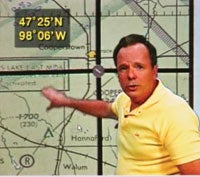 King Schools' John King have helped countless students get into the air King Schools' John King have helped countless students get into the air |
Breakthrough
But until a few lessons ago, I'd still found the airplane a bit stiff in roll and that throttle sticky...until the day Lampson showed up with a CTSW (860LS was down for maintenance).
And as soon as we lifted off, I suddenly felt like I knew how to fly again! The SW was nimble as a spring colt: snappy roll, quick response. That's what I'd been wanting all along---lighter controls. And the throttle? I could slide it without that 90-pound-weakling feeling. We shot eight landings that day. I nailed most of them; suddenly, I felt like a pilot instead of Edward Scissorhands.
Lampson saw the improvement immediately: "You're really controlling the airplane now." He had asked the factory to adjust 860LS's throttle tension and roll-control spring tension and---lo!---the heavens parted! The difference from the "old" CTLS was tangible: I could fly this bird!
At the end of the day, Lampson shook my hand and said, "You'll be ready to solo soon." Now we're talking, brother.
Hitting The Books
Meanwhile, for all those New England bad weather stretches, I'd acquired some study materials to keep me on track. The first goodie box came crammed with DVDs and books, courtesy of ASA, (www.asa2fly.com), the major supplier of aviation software, publications and supplies. ASA produces several DVDs, hosted by sport aviation instructor Paul Hamilton. These are great for newbies to sport flying, in particular Be A Sport Pilot (training overview), Weather To Fly, a thorough grounding in LSA-related meteorology and Sport Pilot: Choosing The Light-Sport Aircraft That's Right For You, a smorgasbord of clips and info on all the LSA types, from powered parachutes to sophisticated high-wingers.
My next fun parcel came from longtime aviation colleague David Jackson, president/CEO of King Schools (www.kingschools.com), and was exactly what I wanted---a thorough CD-based interactive video course for my computer to prep me for the FAA written. John and Martha King do a superb job tag-team teaching in the many video clips---they pretty much wrote the book on aviation visual media learning. And once each clip ends, you're drilled with multiple-choice questions taken from the actual FAA question bank.
I blasted through the dozen CDs, drilled in the course review section, took the test at a local FBO and missed two questions out of 40 for a score of 92. Works for me. If you're into self-teaching like I am, this is the way to go---I loved the King course. It's not a substitute for ground training from your instructor, of course, but a great, endlessly reusable way to retain what you've learned.
And Now...Solo
Rolling off the active, we park at Premier Flight Center (www.premierflightct.com), our friendly home base on HFD. "Well, ready to solo?" Lampson asks. I look up at the sky. The black wall is much closer. "You know, I think I want to wait." "Good call," says Lampson.
Fifteen minutes later, the skies open. After an hour-long downpour, it's time to kick the tires and light the fires. I'm a touch nervous but good to go. Lampson's training has brought me to the point where I know I can handle the airplane well. I run through emergency procedures in my head just in case. And there's that comforting BRS parachute knob just behind my elbow, if the worst should happen.
After run-up and control checks, I taxi to the threshold and make the call. "Brainard tower, light-sport 860 Lima Sierra ready for takeoff. Student pilot, first solo." "Roger that, 60 Lima Sierra cleared for takeoff."
No turning back now. I taxi out and pour the coal to the Rotax, lift off, climb to pattern altitude, enter the downwind, radio a request for the option of touch-and-go or full-stop and here we go.
Throttle back, 15 degrees of flaps, check descent rate. Onto base, looking good, then final...oh dang it, I'm high again! Then I hear my dad's voice, like Obi Wan Kenobi in Luke's cockpit: "Just fly the airplane." I kick in a bit of right rudder and push left stick for a slip---God knows I've had enough practice with this maneuver---and in a few seconds, I'm white over red on the meatballs.
Up comes the ground...relax...relax...keep your speed up...ready to flare, there goes that tail to the right. "RigÂÂht rudder..." whispers Lampson in my head, I ease the pedal in, line up is good and...touchdown. And pardon the brag, but it was a greaser. Yeah, baby!
[Stay tuned! In an upcoming issue, Jim Lawrence takes us through his big checkride day.]

Subscribe to Our Newsletter
Get the latest Plane & Pilot Magazine stories delivered directly to your inbox






